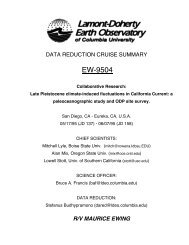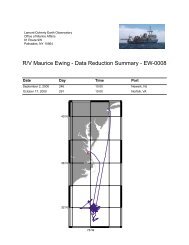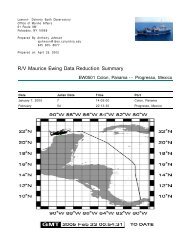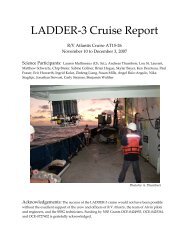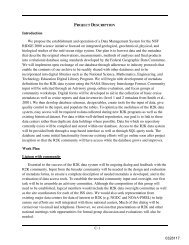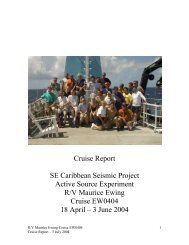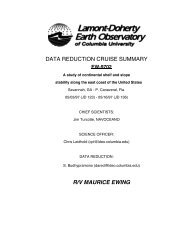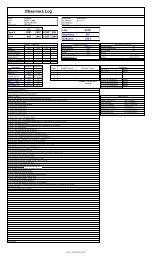NBP09-01 Cruise Report - British Oceanographic Data Centre
NBP09-01 Cruise Report - British Oceanographic Data Centre
NBP09-01 Cruise Report - British Oceanographic Data Centre
- No tags were found...
You also want an ePaper? Increase the reach of your titles
YUMPU automatically turns print PDFs into web optimized ePapers that Google loves.
Figure 31: A south-to-north cross section along the ice shelf front. Velocity (m s −1 , shading, blue indicatesflow out of the cavity) and meltwater concentration (per mille, contours) 1 km seaward of the model’s iceshelf front.8 DynaLiFe, Shedding a Dynamic Light on Iron Limitation in theSouthern OceanThe Southern Ocean plays an important role in the global carbon cycle, due to its large size and uniquephysiochemical characteristics. Approximately 25% of total anthropogenic CO 2 uptake by the oceans takesplace in the Southern Ocean, mainly via primary production by phytoplankton. However, changes in theAntarctic climate may impact phytoplankton primary productivity and hence, the carbon export by theSouthern Ocean. Primary production in the Southern Ocean is dominated by two phytoplankton groupsthat bloom in distinct locations and times: diatoms dominate blooms in shallow mixed layers, whereas thecolony forming Phaeocystis antarctica (Prymnesiophyceae) dominates blooms in the more deeply mixed, openregions. Understanding what controls the dynamics of these two phytoplankton taxa is essential becausethey dominate virtually all polar waters, they have vastly different nutrient utilization characteristics, andboth support very different marine food webs. In addition, this understanding is needed to recognize thepotential impact of climate change on the Antarctic phytoplankton community and predict their role in thecarbon export in the future. The Amundsen polynya and Pine Island Bay polynya are areas with the highestphytoplankton primary productivity in the Southern Ocean as estimated from satellite imagery (Arrigo andVan Dijken 2003) and are therefore vital areas to study phytoplankton primary productivity and carbonuptake in situ.Previous experiments in our laboratory suggest that taxon-specific differences in photoacclimation contributeto the observed distribution. However, photoacclimation does not seem to be the only factor that controlsthe phytoplankton distribution. Iron (Fe) limitation of the algal communities in the Southern Ocean is nowwell documented. Moreover, much of the Fe is bound to organic complexes, so-called ligands. Ligands canincrease solubility of Fe, but the effect on biological availability is unclear. In addition, phytoplankton Fedemand varies as a function of irradiance. Thus, the Fe needs of phytoplankton can change dependent ontheir light environment with great Fe requirements necessary to maintain growth in deeply mixed watercolumns and less Fe required by phytoplankton found in shallowly mixed water columns.<strong>NBP09</strong>-<strong>01</strong> <strong>Cruise</strong> <strong>Report</strong> (p. 49 of 83) Revised February 27, 2009



